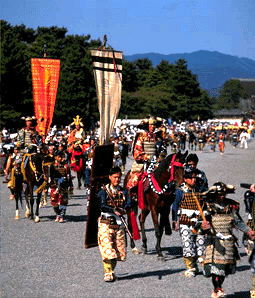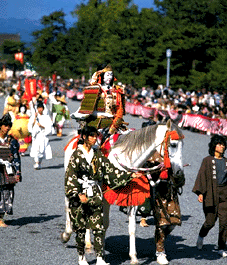ANNUAL CALENDAR October |
|
Kyoto Jidai Matsuri
|
 Jidai Matsuri is one of the three major festivals in Kyoto, the country's ancient capital, the others being the Aoi Matsuri, held in May, and Gion Matsuri, which takes place in July.
Jidai Matsuri is one of the three major festivals in Kyoto, the country's ancient capital, the others being the Aoi Matsuri, held in May, and Gion Matsuri, which takes place in July.
Jidai Matsuri is held around Heian Shrine in the eastern part of the city on October 22. This is the date when Emperor Kanmu moved the nation's capital to Kyoto in 794 and named the city Heiankyo. Heian Shrine is dedicated to Emperor Kanmu and was built in 1895 to commemorate the 1,100th anniversary of the establishment of Heiankyo. Jidai Matsuri was one of the commemorative events that was held then, and it's been held almost every year since. It was launched by an association of residents calling themselves Heian Kosha, set up to maintain and preserve the shrine. The population of Kyoto was around 350,000 during the Edo period (1603-1868) but shrunk to around 220,000 in 1873 after the capital was moved to Tokyo. Local residents feared that their city would gradually decline if nothing was done, and one idea to revive the city was to organize a procession that recreated Kyoto's customs and manners from the first days to Heiankyo to the end of the Edo period. The initial festival featured six processions and around 500 people. Today, there are 18 processions for various historical eras, and participants number about 2,000.  On the day of the festival, two imperial carriages bearing the shrine's principal objects of worship depart from the compounds at nine in the morning. The highlight comes around noon with the parade of historical figures associated with Kyoto, led by isshin kinnotai--a group of late-Edo-period warriors who took Emperor Meiji's side in toppling the shogunal government--and followed by Sakamoto Ryoma (a leader of the Meiji Restoration), Shogun Oda Nobunaga, Murasaki Shikibu (author of the Tale of Genji), Sei Shonagon (who wrote the Pillow Book), and others.
On the day of the festival, two imperial carriages bearing the shrine's principal objects of worship depart from the compounds at nine in the morning. The highlight comes around noon with the parade of historical figures associated with Kyoto, led by isshin kinnotai--a group of late-Edo-period warriors who took Emperor Meiji's side in toppling the shogunal government--and followed by Sakamoto Ryoma (a leader of the Meiji Restoration), Shogun Oda Nobunaga, Murasaki Shikibu (author of the Tale of Genji), Sei Shonagon (who wrote the Pillow Book), and others.
The entire procession is about 2 kilometers (1.2 miles) long, and the paraders march around 4.5 kilometers (2.8 miles) from the Imperial Palace to Heian Shrine. The last person in the procession arrives at the shrine a little after 4 o'clock. Some 12,000 historical artifacts, including costumes, harnesses, accessories, and sandals, are used. These items have been reproduced based on exhaustive historical research and are made or dyed with the same materials that were used to create the originals. Their total value is estimated to be ¥2.5 billion to ¥3 billion ($21 million to $25 million). For this reason, the parade is sometimes called a "walking museum." Spectators get to see much more than just a costumed procession; they're treated to a true-to-life glimpse of Kyoto's rich historical and folk tradition.
Photos: The parade is filled with people in authentic costumes playing historical figures.(Kenzo Yokoyama) |
APR | MAY | JUN | JUL | AUG | SEP | OCT | NOV | DEC | JAN | FEB | MAR |
 |